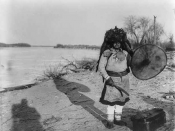Anthropology Essay "To the uninitiated and inexperienced the wind is the wind, a rock a rock, and tree is just a source of lumber or shade; water is for drinking and washing, animals are fleshed-covered bones, and humans are flesh, blood, thoughts and feelings. Take them apart and all you find is smaller pieces of them. Take them down to the atomic level and, viola, they are mostly space (or spirit). They are particles that are really waves or vise versa. At this level, chaos begins to reign for the physicist, but not for the shaman... From the shamanic point of view, there is spirit within all wind, within all rocks and earth, within all plants and trees, water, animals, humans, and every other form of life both animate and inanimate."-Jose and Lena Stevens- A Shaman in most shamanic cultures is portrayed primarily as a healer and a spiritual consultant for his/her community.
Although shamans have many other roles in their communities: sorcerer, medicine man, priest, and psychiatrist, their primary role is to interact between the community and the spirit world. Shamanism is a complex set of practices, beliefs, values and behaviours that enable the practitioner to elect a shift from ordinary consciousness into a trance state with a specific goal in mind, such as healing, obtaining information, power, visions, contacting the spirit of the deceased, and soul retrieval. (Wilson, 2001, paragraph 6) Although shaman's are thought to have "special" and unique powers, " the mainspring of shamanistic power is centred on drugs that produce visual hallucinations as well as hallucinations of the other senses." (Lehman and Myers 2001:121) Shamans utilize hallucinogenic drugs to enter a state of altered conciseness and obtain knowledge and powers needed to heal and also to achieve spiritual oneness. It will also be shown that...


